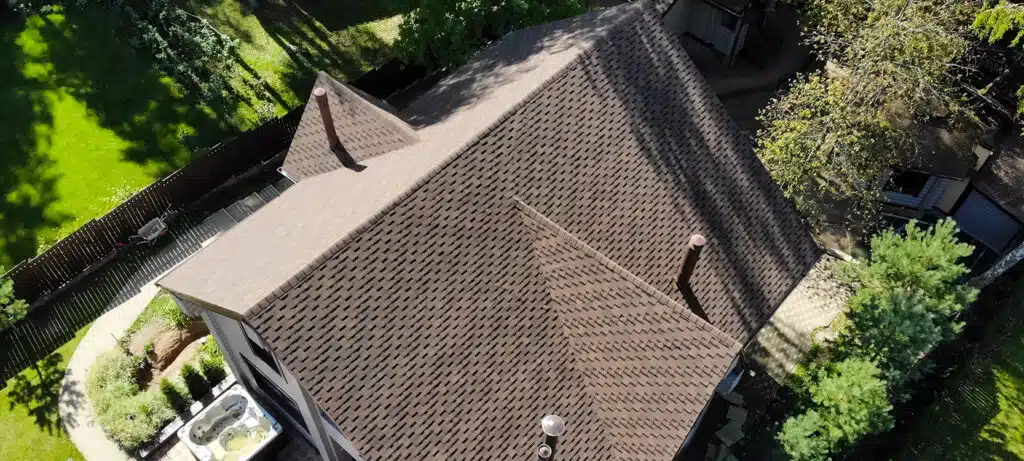Roofing Terms
To better educate you before you meet with a local roofing contractor, you may want to familiarize yourself with some of these common roofing terms. We would be happy to further explain any of this in person…Just give us a call or fill out the request form.
• 3 -Tab Shingle: The most basic and common type of roofing shingle is called the 3-Tab shingle. Since it’s made with 3-tabs, its name is derived from the shape. The 3-tab is a relatively flat shingle without much definition or color variation. Although it’s an economy shingle, it provides many years of serviceable life. The 3-Tab shingle typically comes with a 20 year or 25 year material warranty.
• Cricket: A wood-framed structure that diverts water away from chimneys, walls or other vertical roof projections and penetrations; also called a saddle.
• Deck: The substrate (usually plywood, OSB sheathing, or 1x’s) over supportive framing to which roofing material is applied; also called decking or sheathing.
• Drip edge: Flashing made of steel or other non-corrosive material that is placed along the eaves and rake edges at a 90º angle to let water runoff drop clear of fascia and into the gutters.
• Eave: A roof edge that extends past the exterior wall line.
• Fascia: Vertical roof trim located along the perimeter of a building, usually below the roof level, to cover the rafter tails at the eaves. Also called the boards behind the gutter.
• Felt: Material of interwoven fibers saturated with asphalt and used as a protective under layer between shingles and decking; also called tarpaper.
• Flashing: Metal or other flexible material used to seal the roof and prevent leaks around any projection or intersection, such as pipes, chimneys, dormers, valleys or adjoining walls.
• Flat or low slope roof: A roof with a pitch of less than three feet of rise over a twelve-foot run; this type of roof needs a sealed system installation.
• Hip: The external angle formed by the intersection of two sloping roof planes; from the ridge to the eaves.
• Ice/Leak barrier: A self-adhering and self-healing membrane applied to the roof deck and designed to protect against water infiltration from ice buildup or wind-driven rain.
• Laminated or Architectural shingles: Strip shingles made with fiberglass mat and asphalt that are laminated, or textured, to create a three-dimensional effect. Also called dimensional or architectural shingles. There are also shingles that are called dimensional though they are made from a single material, not two materials laminated together.
• Pitch changes: The variation in the degree of roof incline, which is expressed as the ratio of the rise to the span, in feet.

• Plumbing boot: A prefabricated covering, usually of flexible material, used to seal around a penetration; also called a pipe boot or roof jack.
• Rafter: The structural member supporting the deck and roof system components, extending from the downslope perimeter to the ridge or hip.
• Rake: The inclined edge of a sloped roof over a wall from the eave to the ridge, and usually perpendicular to the eave and ridge.
• Ridge: The horizontal external angle formed by the intersection of two sloping roof planes, i.e., where the two sides of a roof meet at the highest point.
• Ridge vent: A type of roof exhaust vent that ventilates the attic along the ridge or hip line where the roof deck has been cut back; works in conjunction with soffit vents under the eaves.
• Roof ventilation: A static, wind- or power-operated system for removing hot air and moisture from the air under your roof. Includes ridge vents.
• Shed roof: A roof containing only one sloping plane; a single-pitch roof, with no hips, ridges, valleys or gables. Also called a half gable.
• Soffit: The finished underside of the eaves, or roof overhang, which can be enclosed or exposed.
• Soffit vent: An intake vent in the soffit area of the house that provides attic venting at a lower portion of the roof deck and good circulation with other forms of venting such as ridge or roof vents.
• Valley: The internal angle formed by the intersection of two sloping roof planes running from the eaves to the ridge, allowing water to run off.
• Ice and Water shield: A watertight barrier used to seal water out at the eaves and rakes, in valleys, and around chimneys and skylights.

